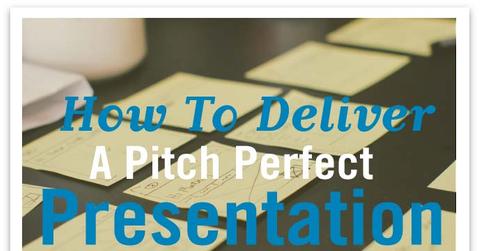How To Deliver A Pitch Perfect Presentation

When I tell people I’m a speechwriter, they’re often pretty impressed. Many people think that speech writing is an innate ability that some of us are born with. I’ve even heard it referred to as a ‘dark art’!
But what most people don’t realize is that they have the ability to be a speechwriter too. Most of us will have to give a speech or a presentation during our working lives. And if you’re an entrepreneur you’ll find yourself pitching to investors, partners and clients on a regular basis.
If you want to improve your presentation skills you might enroll in a public speaking course or hire a coach. These are great steps for helping you to feel more comfortable speaking in front of a group.
But this is only 50 percent of a great speech. How can you possibly become a confident public speaker if you don’t know how to organize what you’ve got to say? To be a stellar public speaker you need to know how write a great speech, presentation or pitch, as well as how to deliver it.
The good news is that becoming a pro at writing speeches, presentations and pitches is not a ‘dark art’. It’s an entirely learnable skill. The most important elements of a great speech are content, structure and style. Here’s how to get to grips with each:
Content:
This is the meat of your presentation. And it should all be organized around one central message or argument. Your audience will probably only remember two or three things you say. So find different ways of reinforcing the same message.
Storytelling is a fantastic technique for doing this. People remember stories because they paint a vivid picture and give the audience characters to identify with. Just make sure your story is 100 percent relevant to your message.
Facts and statistics provide really important evidence, especially if you’re pitching for investment. But think about how you represent those facts.
Don’t say: we have a customer base of 38 million.
Do say: we have a customer base the size of the population of California – more than 38 million people.
The visual image of California will stick in the audiences’ minds much better than a random number. If you want to represent a number in this way, stick it into Google with a phrase like ‘size of’ or ‘population of’ and see what comes up.
Metaphors are a clever way of making a complex topic easy to understand. When I’m talking about speeches I often use the metaphor of a gift. For example: a speech is like a gift you give to the audience, so think about what they’d like to receive.
And to extend the metaphor: the structure is like the box the gift comes in – everything has to fit in the box and it needs to be the right shape, so use a structure that works with your content.
Which brings me onto…
Structure:
A good structure will hold all your content together and make it easier for the audience to understand. There are lots of different ways of structuring a speech – there’s no one size fits all – but my favorite structure is in the shape of a pyramid.
You start at the top (the pointy bit) with a story that illustrates the topic you want to tackle. In the middle you talk about the general issue or problem – this will probably include some facts or statistics. At the base of the pyramid (the most important bit) you show how your speech is relevant to the audience. This might be where you give them an action to do or a takeaway to think about.
The great thing about the pyramid is that the story will get the audience hooked, you’ll have space to evidence your argument, and everyone in the room will know why your speech is relevant to them.
Style:
If you’re making a long speech or presentation you’ll probably write it out word for word.
Here are a few tips to give your speech the professional touch:
-If you’re making a list, make sure it has three items. If you’re using adjectives to describe something, find three. If you’ve got a list of points to support your argument, use three…do you see where I’m going with this? For some reason things in threes sound better, so embrace the power of three!
-If you want your audience to wake up, pose a question. They’re ears will prick up because you’re engaging with them directly.
-Throw in some alliteration – use the same letter at the beginning of closely connected words. It will make your pitch, presentation or proposal more palatable to the audience.
Thinking about how to create engaging content, using a clear structure and employing a few stylistic flourishes, will make your next public speaking appearance more engaging, more accessible and more compelling for your audience.
So when you’re writing you’re next speech, presentation or pitch, don’t forget…
You are a speechwriter too.





